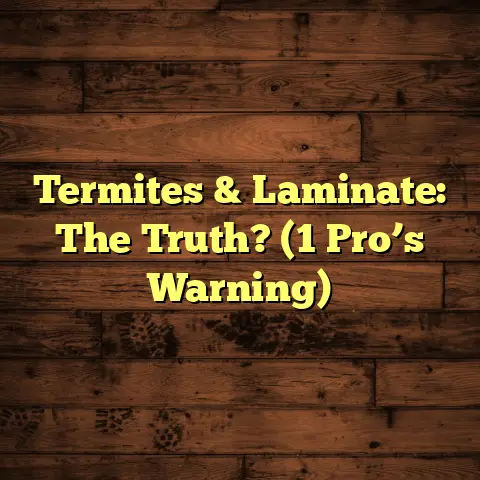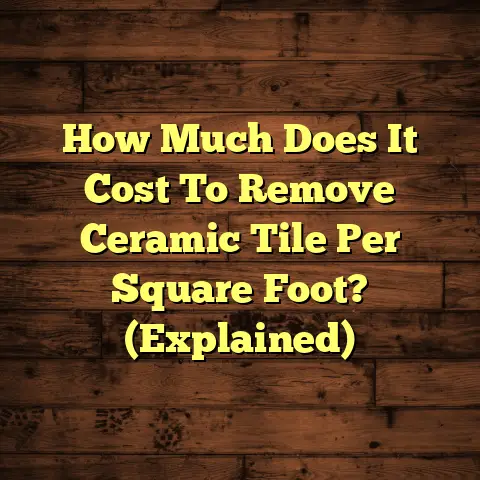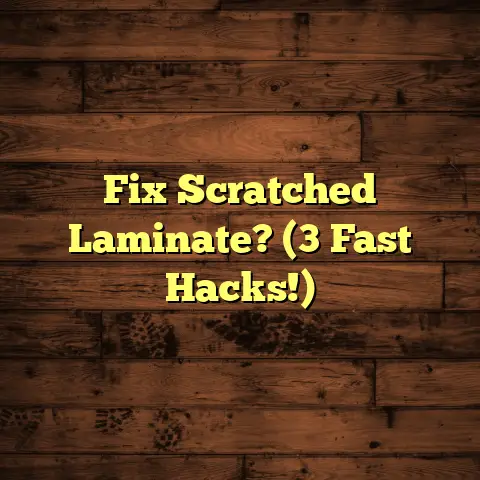Peel & Stick on Wood? (3 Subfloor Fails!)
I’ve seen it all when it comes to flooring, the good, the bad, and the downright ugly.
And let me tell you, peel and stick flooring is a topic that comes up a lot.
It’s appealing, I get it. Easy to install, relatively inexpensive, and comes in a ton of styles.
Plus, many people are drawn to it because of the perceived health benefits.
Let’s dive into that for a second.
The Healthier Side of Peel & Stick
One of the biggest draws of peel and stick, especially in homes with kids, pets, or allergy sufferers, is the potential for a healthier indoor environment.
Think about it: carpet can trap dust, allergens, and even mold spores.
Peel and stick, being a solid surface, is much easier to clean and keep allergen-free.
Lower Emissions: Many modern peel and stick options are also low-VOC (Volatile Organic Compound), meaning they release fewer harmful chemicals into the air.
This is a big deal for indoor air quality, especially if you’re sensitive to chemicals.
Reduced Dust & Allergens: The smooth surface prevents dust and allergens from getting embedded, making it a breeze to sweep or mop.
This can significantly improve air quality and reduce allergy symptoms.
Mold Resistance: Unlike some flooring options, many peel and stick products are naturally mold-resistant, especially vinyl.
This is a huge plus in damp environments like bathrooms or basements.
But here’s the thing: all those benefits can go right out the window if you don’t address the foundation of your flooring – the subfloor.
I’ve seen too many homeowners get excited about the ease of peel and stick, only to run into major problems down the road because they skipped crucial subfloor prep.
That’s why I’m here to break down the three biggest subfloor fails I see with peel and stick, and how to avoid them.
Trust me, a little extra work upfront can save you a ton of headaches (and money!) later on.
Section 1: Understanding Peel & Stick Flooring
So, what exactly is peel and stick flooring?
Simply put, it’s a type of flooring that comes with an adhesive backing. You peel off the protective layer and stick it directly to your subfloor.
Think of it like a giant sticker for your floor.
Composition: Peel and stick flooring typically consists of several layers:
- Wear Layer: The top layer that protects against scratches, scuffs, and stains.
- Print Layer: This is where the design or pattern is printed, mimicking wood, tile, or other materials.
- Core Layer: Provides stability and support.
- Adhesive Layer: The sticky backing that adheres to the subfloor.
- Release Liner: The protective paper that you peel off before installation.
Installation Process: The beauty of peel and stick is its simplicity. No special tools or messy adhesives are needed.
You simply clean and prepare the subfloor, peel off the backing, and stick the flooring in place.
It’s a popular choice for DIYers because it’s relatively quick and easy to install.
Varieties: You’ll find peel and stick in a variety of materials, each with its own pros and cons:
- Vinyl: The most common type, known for its durability, water resistance, and affordability.
- Laminate: Offers a more realistic wood look but is less water-resistant than vinyl.
- Tile: Can mimic the look of ceramic or stone tile, often used in bathrooms and kitchens.
Each type offers different aesthetic benefits, allowing you to achieve the look you want without breaking the bank.
The popularity of peel and stick flooring is undeniable.
According to recent industry reports, the peel and stick flooring market has seen significant growth in recent years.
A report by Grand View Research, for example, projects the global vinyl flooring market, which includes peel and stick options, to reach \$48.75 billion by 2027.
This growth is driven by factors like the increasing popularity of DIY home improvement projects, the affordability of peel and stick flooring, and its ease of installation.
I’ve personally seen a huge increase in customers asking about it, especially renters and first-time homeowners.
Section 2: The Importance of a Proper Subfloor
Okay, let’s talk subfloors.
What is it and why should you care?
The subfloor is the foundation of your entire flooring system. It’s the layer directly underneath your finished flooring, providing a stable and level surface.
Think of it as the canvas for your masterpiece.
If your canvas is warped or damaged, your painting isn’t going to look its best, right?
Same goes for your flooring.
How Subfloor Condition Affects Peel & Stick: The condition of your subfloor directly impacts the performance and longevity of your peel and stick flooring.
A properly prepared subfloor ensures:
- Adhesion: The adhesive backing needs a clean, smooth surface to bond to.
- Stability: An uneven or unstable subfloor can cause the peel and stick flooring to crack, peel, or lift.
- Longevity: A well-maintained subfloor helps prevent moisture damage and other issues that can shorten the lifespan of your flooring.
Common Subfloor Types:
- Plywood: A common choice for wood-framed homes. Plywood can be susceptible to moisture damage if not properly sealed.
- Concrete: Often found in basements and slab-on-grade homes. Concrete can be prone to moisture issues and cracking.
- OSB (Oriented Strand Board): A less expensive alternative to plywood. OSB is more susceptible to moisture damage than plywood and can swell or warp if exposed to water.
Each type of subfloor presents its own set of challenges when installing peel and stick flooring.
For example, concrete subfloors often require extensive cleaning and leveling, while plywood subfloors may need to be sanded and patched to create a smooth surface.
Moisture Control: A Critical Role: Moisture is the enemy of all flooring, but it’s especially detrimental to peel and stick.
Excess moisture can weaken the adhesive, cause the flooring to peel or lift, and even lead to mold growth.
Proper moisture control is essential for ensuring the long-term performance of your peel and stick flooring.
This includes:
- Testing for Moisture: Before installing any flooring, it’s crucial to test the moisture content of your subfloor.
- Using Moisture Barriers: Installing a moisture barrier can help prevent moisture from seeping up from the subfloor and damaging your flooring.
- Proper Ventilation: Ensuring adequate ventilation in your home can help reduce moisture levels and prevent moisture-related problems.
Section 3: Subfloor Fail #1 – Moisture Issues
Alright, let’s get into the nitty-gritty.
Subfloor Fail #1: Moisture Issues.
This is probably the most common problem I see with peel and stick flooring installations.
Excess moisture can wreak havoc on your flooring, leading to a whole host of problems.
How Moisture Causes Failures:
- Curling and Lifting: Moisture can weaken the adhesive, causing the edges of the flooring to curl up or lift.
- Mold Growth: Moisture creates the perfect environment for mold and mildew to thrive, which can be a serious health hazard.
- Adhesive Breakdown: Excessive moisture can break down the adhesive altogether, leading to complete failure of the flooring.
Case Studies: I remember one homeowner, let’s call her Sarah, who installed peel and stick vinyl in her basement without testing for moisture.
Within a few months, she started noticing the edges of the flooring curling up.
Upon closer inspection, she discovered mold growing underneath the flooring.
She ended up having to rip out the entire floor and hire a professional to remediate the mold.
Another homeowner, Mark, installed peel and stick laminate in his kitchen without realizing he had a slow leak under his sink.
The constant moisture caused the laminate to swell and warp, eventually requiring a complete replacement.
These are just two examples of how moisture issues can lead to costly and frustrating problems.
Signs of Moisture Problems:
- Visible Water Stains: Look for water stains on the subfloor or surrounding walls.
- Musty Odor: A musty or moldy smell can indicate the presence of moisture.
- Dampness: Feel the subfloor for dampness.
- Efflorescence: A white, powdery substance on concrete can indicate moisture intrusion.
Moisture Mitigation Methods:
- Moisture Barriers: Install a moisture barrier between the subfloor and the peel and stick flooring.
- Vapor Barriers: A vapor barrier is a type of moisture barrier that is specifically designed to prevent moisture from passing through it.
- Dehumidifiers: Use a dehumidifier to reduce the humidity levels in your home.
- Proper Ventilation: Ensure adequate ventilation in your home to help prevent moisture buildup.
- Sealants: Apply a sealant to concrete subfloors to help prevent moisture from seeping through.
Remember to always test your subfloor for moisture before installing peel and stick flooring.
You can use a moisture meter to measure the moisture content of the subfloor.
According to the EPA, indoor humidity should be kept below 60% to prevent mold growth.
Section 4: Subfloor Fail #2 – Uneven Surfaces
Subfloor Fail #2: Uneven Surfaces.
Peel and stick flooring needs a smooth, flat surface to adhere to properly.
If your subfloor is uneven, you’re setting yourself up for problems down the road.
How Unevenness Causes Problems:
- Poor Adhesion: The adhesive won’t be able to make full contact with the subfloor, leading to weak spots and potential peeling.
- Premature Failure: Unevenness can create stress points on the flooring, causing it to crack, buckle, or wear out prematurely.
- Uncomfortable Walking Surface: You’ll feel every bump and dip under your feet, which can be uncomfortable and even dangerous.
Types of Unevenness:
- Bumps: Raised areas on the subfloor, often caused by nails, screws, or debris.
- Dips: Depressions or low spots in the subfloor.
- Cracks: Cracks in concrete subfloors can create uneven surfaces.
- Warps: Warped or bowed plywood or OSB can create significant unevenness.
Examples of Uneven Subfloor Issues: I had a client, let’s call him Tom, who thought he could get away with installing peel and stick tile over a slightly uneven concrete subfloor in his bathroom.
He figured the adhesive would fill in the gaps.
Big mistake.
Within a few weeks, the tiles started cracking along the grout lines.
He ended up having to tear out the entire floor and hire a professional to level the subfloor before reinstalling the tile.
Another homeowner, Lisa, installed peel and stick vinyl planks over a plywood subfloor that had some minor dips.
She didn’t bother leveling the subfloor, thinking it wasn’t that big of a deal.
Over time, the vinyl planks started to sink into the dips, creating an uneven and unsightly surface.
She eventually had to replace the entire floor.
Leveling Solutions:
- Leveling Compounds: Self-leveling compounds can be poured over concrete subfloors to create a smooth, flat surface.
- Patching Compounds: Patching compounds can be used to fill in small cracks, holes, and imperfections in concrete or wood subfloors.
- Sanding: Sanding down high spots on wood subfloors can help create a more even surface.
- Underlayment: Using a leveling underlayment can help smooth out minor imperfections in the subfloor.
Before installing peel and stick flooring, always inspect your subfloor for unevenness.
You can use a level or a straightedge to check for bumps, dips, and other imperfections.
According to the Tile Council of North America (TCNA), the maximum allowable variation in a subfloor is 1/8 inch in 6 feet or 3/16 inch in 10 feet.
Section 5: Subfloor Fail #3 – Improper Preparation
Subfloor Fail #3: Improper Preparation.
Even if your subfloor is relatively level and dry, it still needs to be properly prepared before you install peel and stick flooring.
Skipping this step can lead to adhesion problems, peeling, and other issues.
Necessary Preparation Steps:
- Cleaning: Thoroughly clean the subfloor to remove any dirt, dust, debris, or old adhesive.
- Sanding: Sanding the subfloor can help create a better surface for the adhesive to bond to.
- Priming: Applying a primer can help improve adhesion and prevent moisture from seeping into the subfloor.
Common Mistakes:
- Not Cleaning Thoroughly: Leaving dirt or debris on the subfloor can prevent the adhesive from bonding properly.
- Skipping Sanding: Sanding helps create a rougher surface that the adhesive can grip onto.
- Using the Wrong Primer: Using the wrong type of primer can actually hinder adhesion.
- Not Following Manufacturer Guidelines: Each peel and stick flooring product has its own specific installation instructions.
Anecdotes & Testimonials:
I had one client, let’s call him David, who was in a hurry to install peel and stick flooring in his living room.
He skipped the cleaning and sanding steps, thinking it wouldn’t make that much of a difference.
Within a few weeks, the flooring started peeling up in several spots.
He ended up having to rip out the entire floor and start over, this time taking the time to properly prepare the subfloor.
Another homeowner, Emily, installed peel and stick tile in her kitchen without reading the manufacturer’s instructions.
She used the wrong type of primer, which actually prevented the adhesive from bonding properly.
The tiles started popping up within a few days.
Manufacturer Guidelines & Best Practices:
- Read the Instructions: Always read and follow the manufacturer’s instructions for your specific peel and stick flooring product.
- Use the Right Products: Use the recommended cleaners, primers, and other products.
- Test a Small Area: Before installing the entire floor, test a small area to make sure the adhesive bonds properly.
- Allow Time for Acclimation: Allow the peel and stick flooring to acclimate to the room’s temperature and humidity for at least 48 hours before installation.
Remember, proper subfloor preparation is essential for a successful peel and stick flooring installation.
Don’t skip this step!
According to the Resilient Floor Covering Institute (RFCI), proper subfloor preparation is crucial for ensuring the long-term performance of resilient flooring products.
Conclusion
So, there you have it: the three biggest subfloor fails I see with peel and stick flooring.
Moisture issues, uneven surfaces, and improper preparation can all lead to costly and frustrating problems.
While peel and stick flooring offers many benefits, including ease of installation and potential health advantages, it’s important to remember that the success of your project depends on the condition of your subfloor.
Take the time to properly assess and prepare your subfloor before installing peel and stick flooring.
It’s an investment that will pay off in the long run.
Don’t let a subfloor fail ruin your peel and stick dreams!
By understanding the potential pitfalls and taking the necessary precautions, you can ensure a beautiful, durable, and healthy floor that you’ll enjoy for years to come.
Happy flooring!





